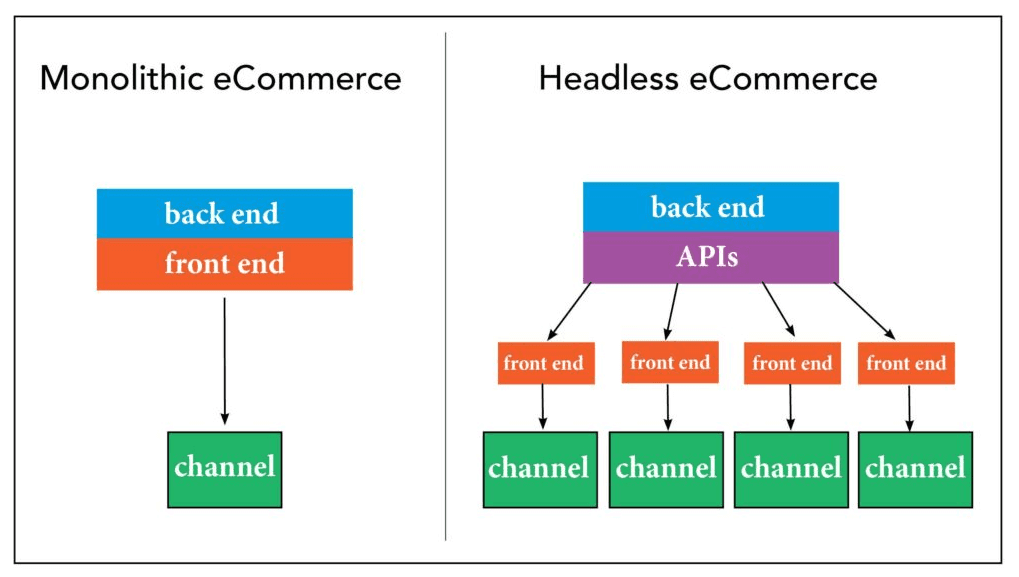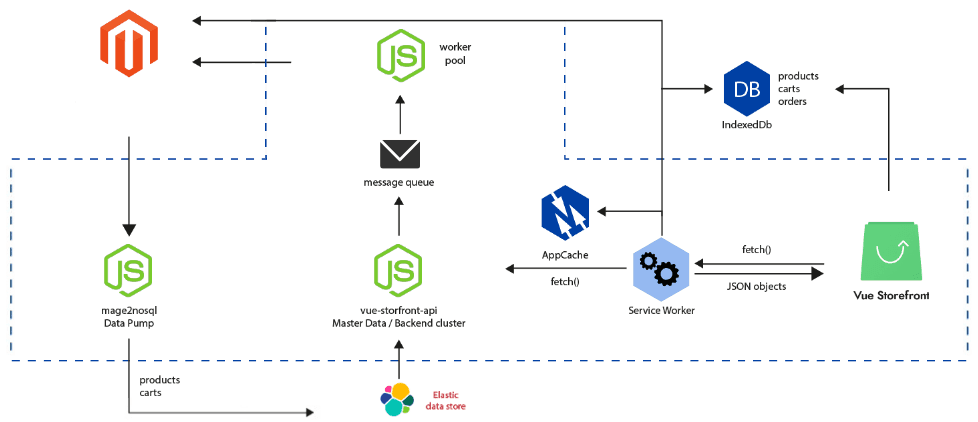Monolithic vs Headless Magento: Which is Better for You?

Customer needs are always changing, and no matter how perfect your ecommerce business model is, you cannot completely prepare for them. This leaves you only one option to survive—be flexible enough to change with the market. When developing your ecommerce business, you can take the traditional, monolithic approach or the headless route.
Each of these models has its share of benefits that suit various businesses. Understanding these differences can help you choose the ideal model for your business. The same rule applies to Magento, the incredibly popular ecommerce platform. In this article, we examine the monolithic vs headless Magento, drawing out their differences and similarities to establish which option is better for you.
What is Monolithic Magento?
If you have used Magento, currently known as Adobe Commerce, the chances are that you have used the monolithic type. This ecommerce software is the traditional version. It involves a front end and back end coupled into one unit.
The monolithic Magento has its customer interface or the front-end presentation layer and the back-end functionality (business logic) tightly integrated into the same codebase. So, anything happening on the front end invariably affects the back end because these two sides of the platform exist in the same codebase.
Key Characteristics of Monolithic Magento
Large codebases that can be cumbersome to manage over time
Inherent system interdependencies
Monolithic architecture with tightly integrated user interface and back-end functionality
Heavy IT dependency
Limited flexibility, personalization, and customization.
Monolithic Magento Pros and Cons
Here are some of the arguments for and against a monolithic Magento.
Pros of Monolithic Magento
Its tightly integrated components create a simple architecture that makes it easier to set up and maintain.
Collaboration on the system can be more straightforward since system developers can work within the same ecosystem.
Monolithic Magento often comes with built-in features that streamline common ecommerce functions.
Cons of Monolithic Magento
The tightly integrated front and back-end components make customizing more complex and challenging, causing limited flexibility.
Scaling and optimizing performance can be challenging as the business grows.
Design and user experience improvements may require significant effort.
What is a Headless Magento

Headless Magento is a more modern approach to Adobe Commerce development, where the front end and back end are decoupled. This separation of the customer-facing layer and the platform’s back-end functionality allows more flexibility and customization.
Since the back-end infrastructure exists on a different codebase with no corresponding customer interface, it enables the use of different front-end technologies to create the user interface. This option liberates ecommerce merchants to be creative with their storefront designs.
The separation also means the business can make necessary changes at the speed of technology without affecting its core business functions. It is just easier to adapt to changing market trends when you have a Magento headless solution.
Key Characteristics of Headless Magento
Decoupled architecture with a separate front end and back end.
API-first development approach
Scalable design
Front-end flexibility and faster innovation
Enhanced customization and personalization
Omnichannel support
Headless Magento Pros and Cons
This section contains the strengths and limitations of headless Magento that can determine if it is a suitable choice for your business.
Benefits of Magento in Headless
Headless Magento allows the flexibility to use various front-end technologies, making it adaptable to the latest design trends.
It is highly scalable, thanks to the headless architecture that can accommodate additional resources on demand.
The headless platform is highly customizable and supports personalized customer experiences.
It provides excellent omnichannel support, consistent with modern customer needs.
It supports limitless integrations.
Limitations of Headless Magento
The system is complex, so it can be challenging to set up and maintain a headless Magento store.
You may need a specialized team with expertise in both front-end and back-end technologies with a headless Magento platform.
The added flexibility and customization may come at a higher cost.
Monolithic Vs. Headless Magento Head-to-Head
Ecommerce businesses have diverse needs, and selecting the right architecture for your Adobe Commerce store is crucial.Let’s explore the differences between Monolithic and Headless Magento to help you decide which aligns better with your ecommerce needs and goals.
Architecture
As the name suggests, a monolithic Magento has a monolithic architecture, while the headless Magento architecture is decoupled.
In a monolithic architecture, the front-end layer (the part comprising the user interface or what the user sees) and the back-end infrastructure (where data processing and storage occur) are tightly coupled. As such, both layers (front end and back end) are part of a single codebase in a monolithic system. Naturally, they also typically run on the same server.
Headless Magento, on the other hand, has the front-end presentation layer separate from the back-end functionality. Therefore, these two sides of the system exist on different codebases and often run on different servers.
The back end in a headless Magento becomes a service (termed the head), and the front end uses this service.
The two separate layers then exchange data seamlessly through APIs. The common API frameworks for headless Magento 2 are RESTful and GraphQL.
Verdict: Headless Magento architecture is more complex but excellent for growth-oriented businesses.

Flexibility and Customization
In Monolithic Magento, the platform’s capabilities determine the level of customization you can achieve with your storefronts. The system usually has a platform and a corresponding template for designing the front-end layer.
Your storefront design is, therefore, limited to the themes and template designs available with your platform. This quality can significantly limit customization and personalization. Yet, 76% of consumers are more likely to buy from a brand that personalizes their experiences.
In comparison, headless Magento is a backend-only solution. With that comes the flexibility to choose your preferred tech stack and the best tools for creating user experiences.
Since the headless Magento platform lets you create the front end, you can choose a front-end-as-a-service (FEaaS) platform or develop custom front ends from scratch.
In other words, the customization and personalization options with a headless Magento are almost limitless.
You have complete control over your front-end design and can tailor the site’s content to be dynamic, personalized, and to the customer’s taste.
Verdict: Headless Magento wins the round.
Front-end Development
Since the front end is tightly integrated into the back end of a monolithic Magento platform, its development is limited to the Magento platform’s built-in theming and templating system.
This architecture might restrict or limit front-end developers from using newer front-end development technologies and approaches.
The front and back end live in the same codebase, so any changes in the system invariably affect both sides regardless of where it is implemented. For instance, any change you make to the front-end layer will affect the back-end functionality, which can lead to undesirable downtimes.
Headless Magento has a decoupled front end, which carries a host of front-end development benefits. Even though creating a new front-end end solution can take time and resources, that is as far as the disadvantage goes.
Developers can create custom, innovative user experiences using a modern technology stack, such as Vue.js, React, and Angular.
Verdict: Headless Magento supports innovative and more tailored front-end development.
Performance and Speed
Monolithic Magento platforms may experience slower site speeds due to the sheer size of code that must be loaded and rendered to display a page.
Everything on this platform runs as a single unit, so the entire (heavy) code must be loaded each time a user requests a page. With such an architecture, potential bottlenecks and overheads can be common, especially for large sites or during high-traffic situations.
Headless Magento solves this situation by decoupling the front end from the heavy back-end infrastructure.
When users request a page on a headless Magento site, only the light front-end code is loaded. This ensures quicker page loads, better performance, and enhanced user experience.
The decoupling also means you can scale the back end and front end separately, leading to improved performance during high demand.
Verdict: Headless Magento trumps its monolithic cousin in terms of performance and speed.
Content Management
Monolithic Magento offers a built-in content management system (CMS), making it simpler to manage content. Headless Magento allows for integration with specialized CMS platforms like Contentful for more advanced content management.
While the monolithic option simplifies things and may allow you to save on the cost of a third-party CMS, it is usually limited in performance. Headless CMS platforms are usually robust and allow more control over your content management. This way, they can let you better comprehend conversion optimization.
The solutions allow for continuous testing and optimization, which can contribute to improved customer satisfaction and better conversions.
Verdict: Headless Magento allows for more personalized content management.
Scalability
Website traffic tends to grow as your ecommerce business grows. Handling increased traffic requires additional server resources and might cripple the site’s performance if the required resources are not allocated proportionately or on time.
Additional traffic means additional demand, which can strain the site’s resources. Note that a monolithic architecture is less flexible and can limit your ability to scale with increased demand.
While both headless and monolithic architectures can scale, they go about it differently. A headless platform allows you to scale the front end and back end separately, making it easier.
You can allocate additional server resources to the back end during peak times without altering the front end where customer interactions happen. Making such changes on a monolithic system might mean downtimes, which are unwelcome during peak times.
Verdict: Headless Magento is more scalable than a monolithic Magento.
Security
Monolithic Magento may have potential security risks due to its tightly integrated nature. Any attacks on the front end will likely affect the back end because the two sides are part of the same codebase.
In contrast, a headless Magento platform can be more secure as it allows for the separation of the front end from the back end.
The two sides of the system belong to different codebases, which can go a long way in mitigating attack vectors on the front end.
Verdict: Headless Magento can provide more security to customer data on the back end.
Cost Considerations
Since the monolithic Magento provides the themes and templates for creating its front end, you will require less developer investment to create your storefront. It also usually has its content management system, hence the reduced need to invest in a third-party CMS solution.
These factors may make a monolithic solution more cost-effective upfront.
Headless Magento has added costs, including developing custom front ends and other third-party integrations. However, its flexibility and scalability can justify these costs in the long run.
Verdict: Monolithic Magento is more cost-effective upfront.
User Experience
Headless Magento allows for a superior user experience, as it can adapt to the latest design trends and technologies more easily.
With headless Magento, you can create personalized user experiences by building custom front ends across various channels. This can allow customers to enjoy omnichannel experiences.
According to a recent study, two-thirds of customers will likely not buy from a brand that does not provide integrated omnichannel experiences. You could lose up to 59% of customers willing to purchase from a competitor offering better shopping experiences.
Since a monolithic Magento back end cannot support more than one front end, you may have to create a new content delivery architecture whenever you want to offer content to more touchpoints. This makes the conventional Magento less suited for providing omnichannel customer experiences.
Verdict: Headless Magento has better omnichannel support.
Which is Better Between Monolithic and Headless Magento?
If this were a head-to-head contest, headless Magento wins it hands down. But that might not be the most helpful way to argue this out. So, let’s break it down.The headless architecture of the modern Magento opens many doors for Magento 2 store development and could potentially future-proof your business.
If you want to scale and build a business of the future, the headless Magento should be an intuitive choice.However, if you currently use the monolithic Magento and it is serving your business needs well, you may not need to go headless. Stick with the monolith.
Monolithic vs Headless Magento: Final Verdict
In this article, we have compared Magento headless and monolithic platforms and suggested when to use each. We have also discussed the features of each solution and provided their pros and cons.The features we have compared include the following:
User Experience
Cost Considerations
Security
Scalability
Content Management
Performance and speed
Front-end Development
Flexibility and Customization
Architecture
Next, we’ll discuss and provide rich insights about developing and implementing Magento, so keep an eye out for that.If you want a personalized evaluation of your ecommerce business options, then the team of headless Magento experts at Endertech can help. Schedule a free consultation call.
